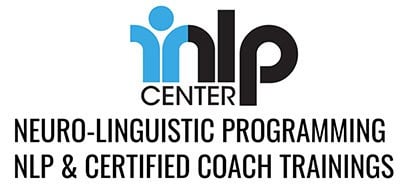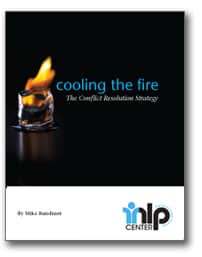 Here’s what some of our students have said about our Cooling the Fire program:
Here’s what some of our students have said about our Cooling the Fire program:
Canale D.: I love the concept of this tool. I have always been a retaliator when attacked because i thought i was defending myself but this makes perfect sense to diffuse the situation then when all the adrenalin calms down we can communicate properly . I will definitely try my best to adopt this approach. (Even if i get one attack back then start this approach haha) Thanks INLP
Swart J.: This looks like an excellent tool. I like that the first thing it seems to do is get us to choose a conscious strategy instead of an unconscious one. Then, by virtue of the responses themselves (seeking information & giving information) we are automatically led into a different attitude toward the other person. We must drop the attitude of having a position to defend in order to step into the attitude of curiosity about the other. It seems to me that this change in attitude is in itself the real meat of what makes this approach effective.
Johnson N.: In the Karen/Larry example, the last thing Larry says is “… I love you and I don’t want you to be upset. Do you have time to listen now?” – this has been indicated as “still seeking info” – but it is actually a combination of giving information (I love you and … upset), and seeking info. It is just common-sense to resolve conflict in this manner.
Lagneryd E.: Interesting. We are a couple that recognize patterns in heated situations. We are sure that this is a good tool.
Ponti L.: Thanks so much. Very practical and I’ll apply it the first chance I get! The counterintuitive part intrigues me. Since we don’t usually think particularly well during conflict why would I trust my judgement in a heated moment that’s being carried along emotions? My new mantra is “manage your state”.
Ponkin S.: “Cooling the Fire”. This is very interesting! I discovered it to be a very useful tool in communication with children. It really helps to give information instead of asking questions when kids don’t want to talk to you. Really helpful!
Rose D.: I am very much looking forward to learning the material. INLP Center explains the introduction very clearly.
Marshall M.: It seems simple enough. A lot of it is self awareness, so we don’t just react, but to be aware enough to put the brakes on our own reactions and tap into these techniques. A problem I can forsee is the person who physically withdraws. Following may be perceived as an attack.
Conway K.: I liked this mode for conflict resolution it seems to fit right, now to practice it.
Kamar M.: The jury’s still out. I have high expectations and so far it looks like they will be met.
Stoudt T.: What insight! and useful..
Spessard J.: I’m liking this entire AHA program. When I originally bit on their $99 promotion I was “meh…their articles seem OK. Lets roll the dice on these guys and see if I get value”. What a dice roll that was. I won! These courses are addressing gaps in my knowledge that weren’t getting addressed from my hometown NLP center. “Cooling the Fire” showed me rules of the conflict game that I have violated many times. My gf and I will be using this stuff on each other. I’m also LOVING the Tame the DMN stuff. It is exactly what both I and my gf need and my next priority. I’ve had a lot of shifts from taking NLP courses in my life in brick&mortar NLP centers. This internet AHA program is perfect for filling those weaknesses I have. I am so happy with getting these products. And trust me, I NEED all the help I can get right now so I’m arming myself w/ all the NLP knowledge I can.
Silva K.: I found this unit to be extremely helpful in gaining an understanding of an “attack”. I feel that the information I have gained from this unit will enable me to understand what the person who is attacking is feeling as well as I why I have attacked myself in the past. For now I will be working on identifying an attack and practicing to seek information to diffuse the attack.
Lewis J.: I am going to start using this now with my wife! I will also employ with business clients.
Wingard A.: I consider the conflict map and guidelines very useful. I have used them without even know it but I still need to practice them. I find myself more in Abandon conflict. I have difficulties in expressing my oppinion because I am afraid I will lose people respect. Recently I have started to become more confident in my English and I got the desired position. Thinking back, I realized it wasn’t about the perfection of the language I used but my low self esteem. I am happy to be here and learn how to change my limiting beliefs and get rid of self-sabotage.
Vesel C.: In addition to learning how to resolve conflict, this module helped me realize what my default conflict strategy is: Abandon. The technique is simple on paper, but I hope to put it into practice soon! (I could have used it at 1am this morning…)
Chant R.: Such great, really practical strategies, that I believe any one can implement – i can so relate to the tug of war power play that gets carried out when our emotions flying high and can see already how this will counteract that power play and tug of war. I really look forward to challenging myself by using these two rules of ‘seeking info’ and ‘giving info’ at the appropriate times and the inner power that will develop from ‘managing my state’. Cheers and smiles Robyn 🙂
McDonald S.: This is an excellent lesson that I am hoping to put into practice soon. I have been known to be fairly hot headed in conflict and react in ways that fueled the fire but I think that this will be very helpful in future encounters! Thank you!
Leslie S.: Controlling my own emotions, at the beginning especially, is often the hardest part for me, but I am getting better. I appreciate the fact that I’m getting tools I can actually use to get control of my communications with others.
Mancini V.: I appreciate the conflict map and I have used this technique in my professional life and as well as my personal life. The greatest obstacle that I have had to overcome is to keep calm and level headed when these situations arise. I must admit that I still have not perfected the technique because as was mentioned in the audio portion of this lesson the normal mode to go into is the defense mode when having feelings of being attacked. That’s the problem I am not always in a calm and grounded mood.
I have found that I must keep conscious of my mood so I may defuse my defenses and put myself in a calm grounded state of mind. I feel meditating on being grounded and setting up anchors for me has been a great help. Thank you for enlightening me on the mechanics of the conflict resolution method.


